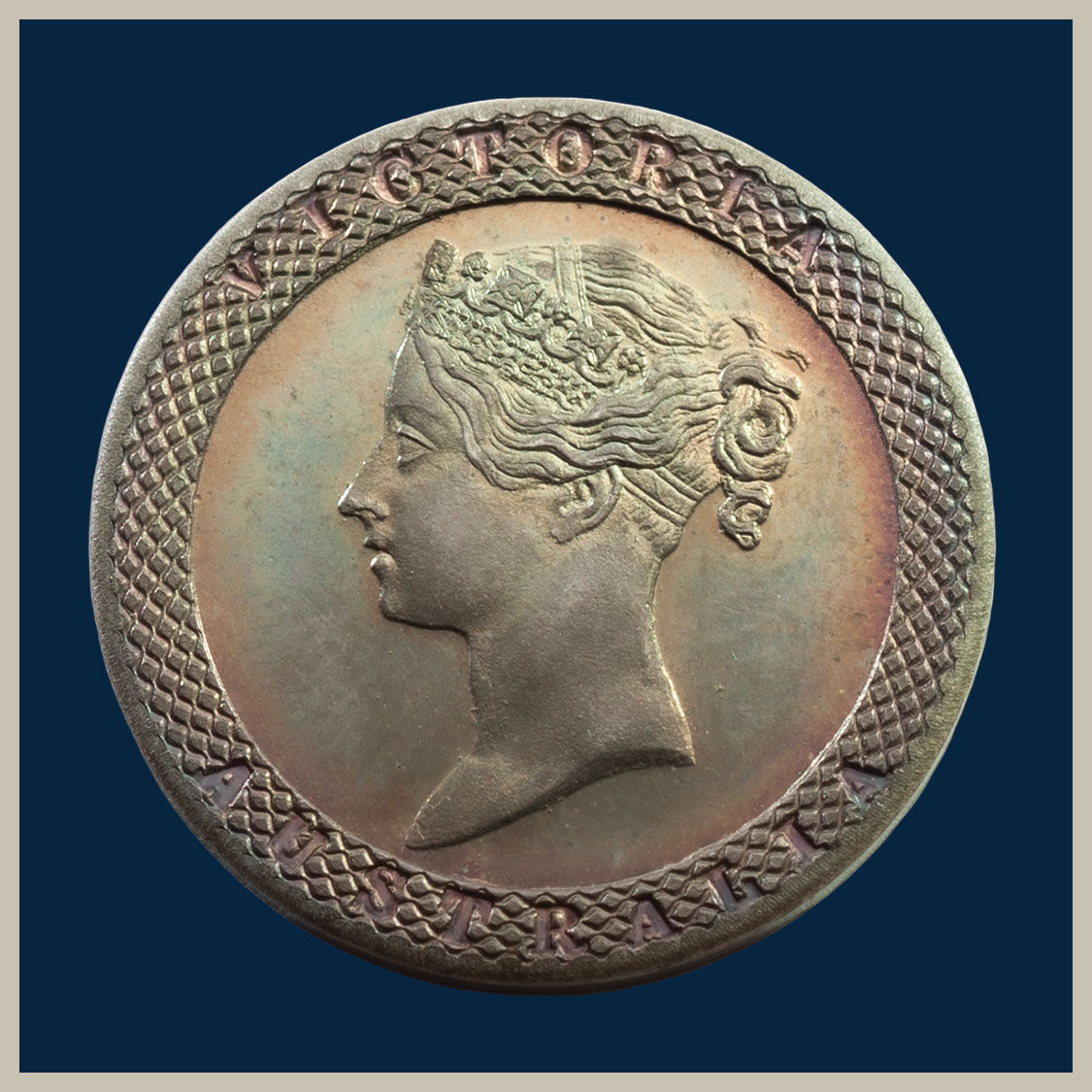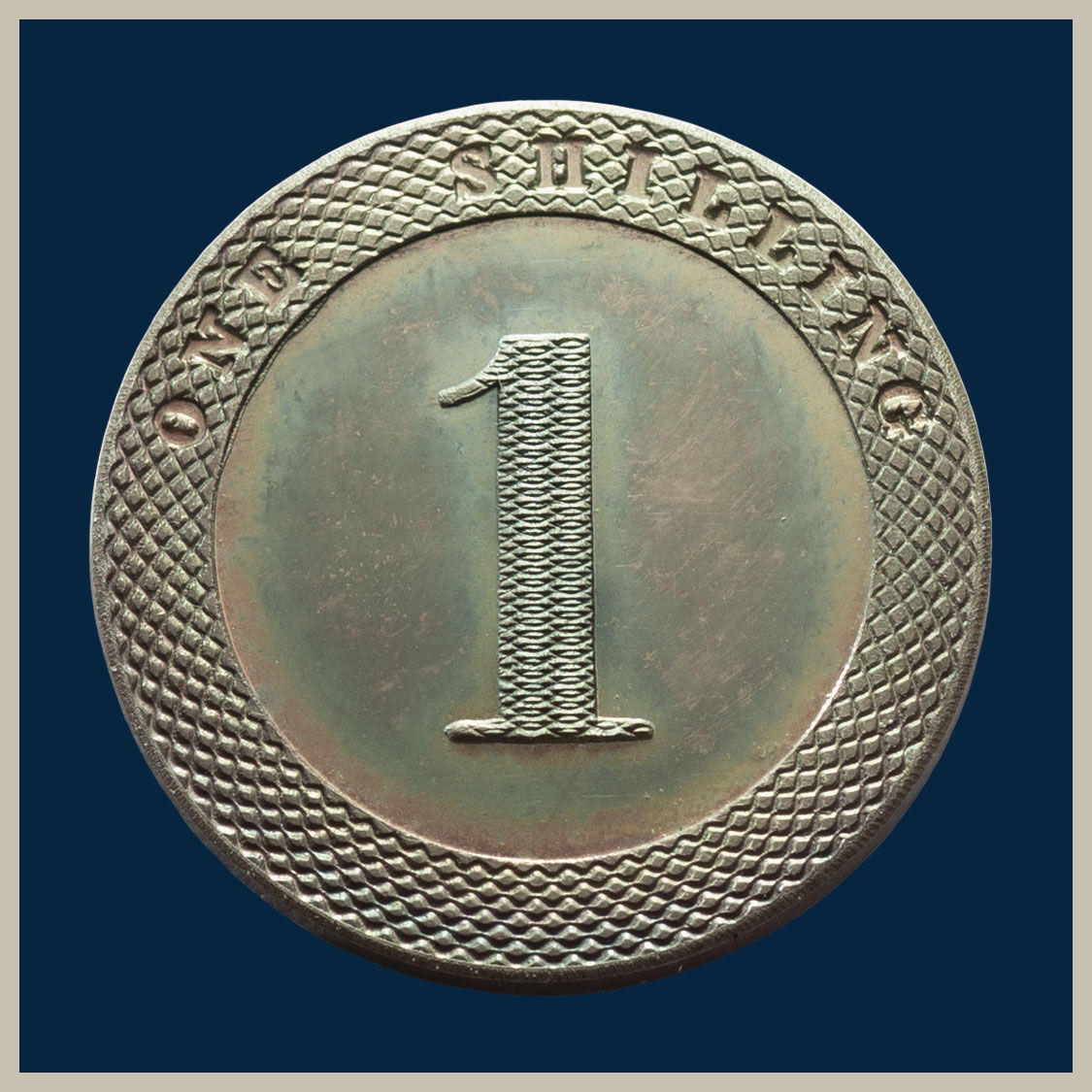Circa 1860 Port Phillip, Kangaroo Office Pattern Shilling and Sixpence, struck in silver, plain edge

History has judged British entrepreneur William Taylor a 'big noter'. He aspired to own and operate a private mint in Melbourne and create a new gold coinage for the colonies. The mint was called the Kangaroo Office and opened in May 1854. Taylor ultimately embraced other metals and struck coins in silver and copper, aluminium and even pewter. They are extremely rare and have been owned by some of history's most lauded collectors, Britain's Hyman Montague and John G Murdoch, Egypt's King Farouk and America's J. J. Pitman. And Australian collectors Philip Spalding and Tom Hadley of Quartermaster fame. This perfectly matched pair was acquired by Coinworks in 2002 from Barrie Winsor, who had acquired them from renowned US dealer Wayte Raymond. They are magnificent! We can certainly attest to their rarity this being the second only pair we have sold over the last twenty-five years.
This pair of Kangaroo Office Shilling and Sixpence was last sold in 2002. And it is true, that over the last two decades we have made several attempts, to lure these coins back onto the market, with no success. The owner simply wouldn't part with them, well aware that the quality made them irreplaceable.
A change of circumstances now sees them offered for sale. They are quality-wise incomparable. The Kangaroo Patterns are exceedingly scarce and become available on the market perhaps once every five years. But a matched pair, comprised of coins of this calibre, is a once-in-a-lifetime opportunity.

Kangaroo Shilling Obverse

Kangaroo Shilling Reverse

Kangaroo Sixpence Obverse

Kangaroo Sixpence Reverse
Technical details of the Kangaroo Office Shilling
Obverse:
Displays a broad raised engine-turned rim encircling a superb portrait of Queen Victoria wearing a jewelled crown, thought to be executed by William Taylor in 1855, and the words VICTORIA and AUSTRALIA incused in the rim.
Reverse:
Displays a broad engine-turned rim encircling a large figure ‘1’ in the centre decoratively engraved and the words ONE SHILLING incused in the rim.
An engine-turned rim refers to a decorative pattern created by a machine-operated process whereby fine, closely spaced, criss-crossing lines are engraved into a surface. The result is a visually appealing, textured surface that adds a touch of elegance and sophistication.
Technical details of the Kangaroo Office Sixpence
Obverse:
Displays a broad raised engine-turned rim encircling a superb portrait of Queen Victoria wearing a jewelled crown, thought to be executed by William Taylor in 1855, and the words VICTORIA and AUSTRALIA embedded in the rim.
Reverse:
Displays a broad engine-turned rim encircling a large figure ‘6’ in the centre decoratively engraved and the words SIX PENCE incused in the rim.
Soon after the opening of the Adelaide Assay Office in 1852, and the striking of the Adelaide Pound - the nation's first gold coin - there was an attempt to establish a private mint in Melbourne.
The mint was called the Kangaroo Office. Its prime goal was to buy gold at cheap prices direct from the fields and convert the precious metal into 'coins' of a fixed weight that would be released at their full value in London.
The plan was devised by English entrepreneur, William Joseph Taylor. By trade Taylor was an engraver and die sinker, active in the numismatic industry producing both coins and medals. He formed a syndicate to finance the operations with two colleagues, Hodgkin and Tyndall. The total investment was £13,000.
Taylor's mint was only one component of a broader-reaching enterprise that was based in London. The overall plan was to profit from all aspects of the Gold Rush and included a clipper ship - called the Kangaroo - that would bring migrants and goods from England to Melbourne and return with gold in its specially outfitted strongroom.
The Kangaroo sailed from London on 26 June 1853. On board, the pre-fabricated structure to house the mint and the shop. And the coining press, dies and two employees, Reginald Scaife, the Manager, and William Morgan Brown, his assistant. The ship arrived at Hobsons Bay, Melbourne on 26 October 1853.
The Kangaroo Office got off to a bad start as there were no facilities at the wharf for off-loading heavy equipment, such as the coining press. With no other option available, the press was dismantled, moved and reassembled, a process that took six months.
The Kangaroo Office eventually commenced operations in May 1854, striking gold coins. To thwart currency laws, the designs were made to look more like weights than coins. Taylor himself cut the dies for a 2oz, 1oz, 1/2oz and ¼oz gold piece, each dated 1853.
The coins were exhibited at the Melbourne Exhibition of 1854 (17 October - 12 December) and were written up in the Argus Newspaper as "several tokens of pure Australian gold were exhibited by Mr. Khull, bullion broker. They were manufactured by Mr. Scaiffe and are to be exhibited at our Palace of Industry."(Sadly a price was never quoted.)
Apart from the logistical difficulties of setting up business, the financial viability of the Kangaroo Office came under an immediate cloud. By mid-1854 when the mint became operational the price of gold had moved up to £4/4/- an ounce, vastly different to the £2/15/- per ounce when the plan was hatched. And there was a glut of English sovereigns in circulation.
By the middle of 1854, Reginald Scaiffe, the Kangaroo Office Manager, had an overwhelming sense of failure for the shop had taken less than £1 in trading, he had a ten-year lease, could not find cheap labour. Nor cheap gold. And basically had no customers.
Despite the financial challenges of the operation Taylor was unconvinced that his days as a coin designer and manufacturer were at an end. In 1855 he produced dies for the striking of a sixpence and shilling in gold, silver and copper. This was his first attempt at producing a piece depicting a value rather than a weight.
The coins were struck with a milled and plain edge, the former believed minted circa 1855, the latter circa 1860.
The sixpence and shilling featured the same broad engine-turned rim as the earlier minted gold coins. The obverse however featured a superb portrait of Queen Victoria with VICTORIA and AUSTRALIA embedded in the rim. The reverse featured the denomination in figures at the centre and in letters embedded in the rim above.
Taylor operated his Kangaroo Office for three years during which time he sustained substantial losses. With all hope of a profit gone, the dispirited promoters in London issued instructions for the Kangaroo Office to be closed.
Now while it is true that Taylor never achieved his ambitions, the Kangaroo Office coins are revered by collectors right across the globe.
Soon after the opening of the Adelaide Assay Office in 1852, and the striking of the Adelaide Pound - the nation's first gold coin - there was an attempt to establish a private mint in Melbourne.
The mint was called the Kangaroo Office. Its prime goal was to buy gold at cheap prices direct from the fields and convert the precious metal into 'coins' of a fixed weight that would be released at their full value in London.
The plan was devised by English entrepreneur, William Joseph Taylor. By trade Taylor was an engraver and die sinker, active in the numismatic industry producing both coins and medals. He formed a syndicate to finance the operations with two colleagues, Hodgkin and Tyndall. The total investment was £13,000.
Taylor's mint was only one component of a broader-reaching enterprise that was based in London. The overall plan was to profit from all aspects of the Gold Rush and included a clipper ship - called the Kangaroo - that would bring migrants and goods from England to Melbourne and return with gold in its specially outfitted strongroom.
The Kangaroo sailed from London on 26 June 1853. On board, the pre-fabricated structure to house the mint and the shop. And the coining press, dies and two employees, Reginald Scaife, the Manager, and William Morgan Brown, his assistant. The ship arrived at Hobsons Bay, Melbourne on 26 October 1853.
The Kangaroo Office got off to a bad start as there were no facilities at the wharf for off-loading heavy equipment, such as the coining press. With no other option available, the press was dismantled, moved and reassembled, a process that took six months.
The Kangaroo Office eventually commenced operations in May 1854, striking gold coins. To thwart currency laws, the designs were made to look more like weights than coins. Taylor himself cut the dies for a 2oz, 1oz, 1/2oz and ¼oz gold piece, each dated 1853.
The coins were exhibited at the Melbourne Exhibition of 1854 (17 October - 12 December) and were written up in the Argus Newspaper as "several tokens of pure Australian gold were exhibited by Mr. Khull, bullion broker. They were manufactured by Mr. Scaiffe and are to be exhibited at our Palace of Industry."(Sadly a price was never quoted.)
Apart from the logistical difficulties of setting up business, the financial viability of the Kangaroo Office came under an immediate cloud. By mid-1854 when the mint became operational the price of gold had moved up to £4/4/- an ounce, vastly different to the £2/15/- per ounce when the plan was hatched. And there was a glut of English sovereigns in circulation.
By the middle of 1854, Reginald Scaiffe, the Kangaroo Office Manager, had an overwhelming sense of failure for the shop had taken less than £1 in trading, he had a ten-year lease, could not find cheap labour. Nor cheap gold. And basically had no customers.
Despite the financial challenges of the operation Taylor was unconvinced that his days as a coin designer and manufacturer were at an end. In 1855 he produced dies for the striking of a sixpence and shilling in gold, silver and copper. This was his first attempt at producing a piece depicting a value rather than a weight.
The coins were struck with a milled and plain edge, the former believed minted circa 1855, the latter circa 1860.
The sixpence and shilling featured the same broad engine-turned rim as the earlier minted gold coins. The obverse however featured a superb portrait of Queen Victoria with VICTORIA and AUSTRALIA embedded in the rim. The reverse featured the denomination in figures at the centre and in letters embedded in the rim above.
Taylor operated his Kangaroo Office for three years during which time he sustained substantial losses. With all hope of a profit gone, the dispirited promoters in London issued instructions for the Kangaroo Office to be closed.
Now while it is true that Taylor never achieved his ambitions, the Kangaroo Office coins are revered by collectors right across the globe.
© Copyright: Coinworks